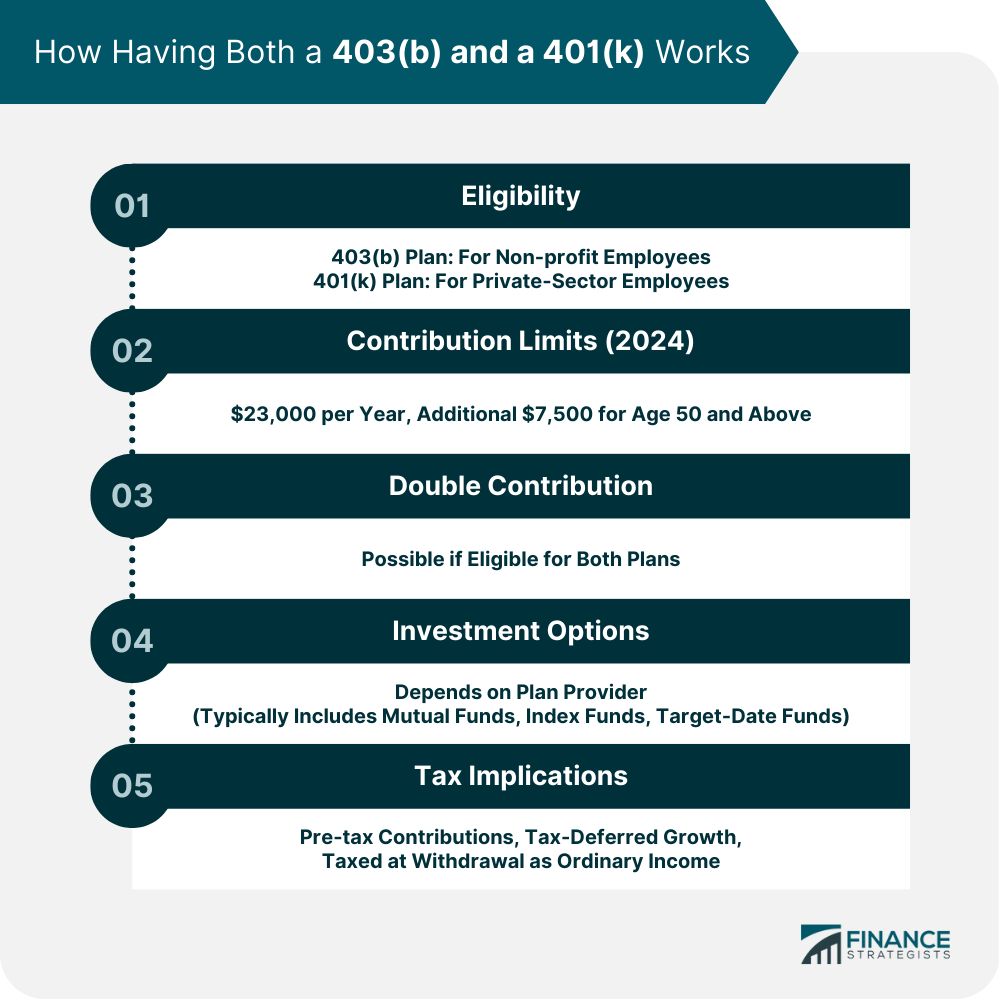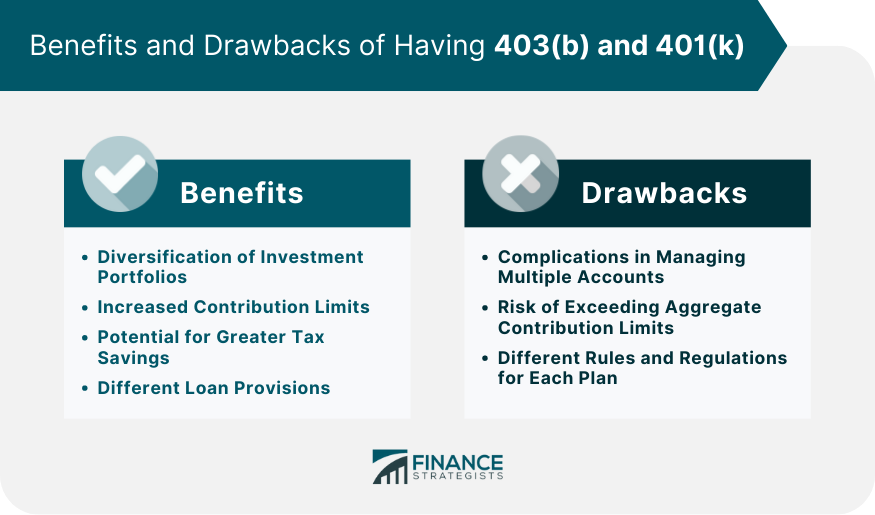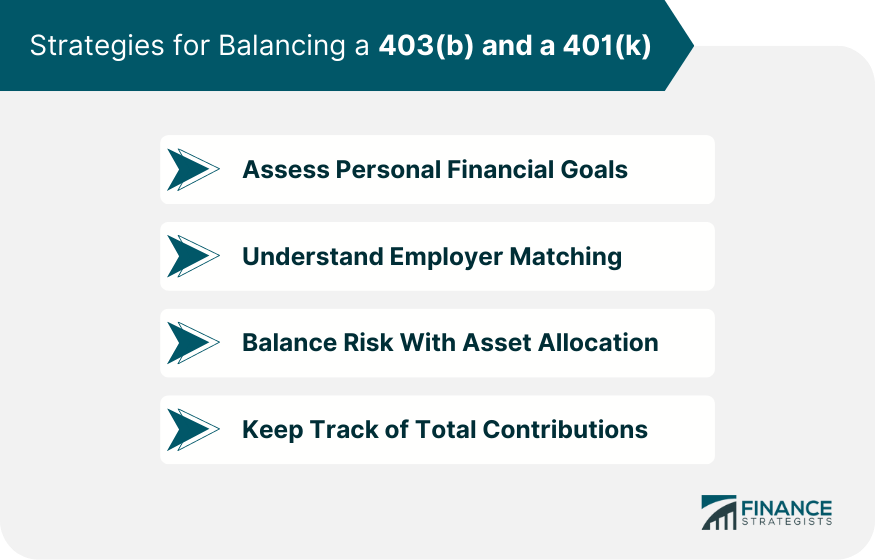Yes, it's possible to have both a 403(b) and a 401(k) and contribute to both, typically if you hold multiple jobs or have transitioned between employers that offer different plans. Having both allows you to potentially increase your pre-tax retirement contributions, diversify your investments, and maximize tax savings. However, it also requires careful management. Each plan has its own rules, and there are also overall limits for all defined contribution plans to be aware of. Therefore, it's crucial to balance your contributions, understand each plan's details, and consider how each fits into your overall financial goals. You may also need to track the performance of investments across both accounts, which can be more complicated than managing a single account. To contribute to both a 403(b) and a 401(k), you need to be eligible for both types of plans. This usually means you're working in two different types of jobs—perhaps part-time in a non-profit (which offers a 403(b)) and part-time in a private-sector job (which offers a 401(k)). Alternatively, you may have rolled over a 401(k) from a previous employer into a 403(b) with a current employer. The IRS sets limits on how much you can contribute to these plans. For both 403(b) and 401(k) plans, the limit is $23,000 as of 2024. However, if you're 50 or older, you can make catch-up contributions of an additional $7,500 per year. Importantly, these limits apply separately to each type of plan. That means if you have both plans, you can potentially double your pre-tax retirement contributions. Both 403(b) and 401(k) plans offer a range of investment options, typically including mutual funds, index funds, and target-date funds. However, the specific choices available will depend on the plan provider and your employer's selections. Contributions to both 403(b) and 401(k) plans are made pre-tax, reducing your taxable income for the year. The funds then grow tax-deferred until retirement, at which point withdrawals are taxed as ordinary income. The tax advantages of using both types of accounts can be significant, especially if you're in a high tax bracket now and expect to be in a lower one in retirement. Having both types of accounts can offer more opportunities for diversification, especially if the investment options in the plans are different. Diversification can help spread risk across different types of investments and potentially enhance returns over time. As mentioned, contributing to both a 403(b) and a 401(k) can effectively double your annual pre-tax retirement savings. This can be a huge advantage if you're trying to catch up on retirement savings or simply want to save as much as possible. With the ability to contribute pre-tax dollars to both plans, you can significantly reduce your taxable income. This can be particularly beneficial if you're in a high tax bracket. Some 403(b) and 401(k) plans offer loan provisions, allowing you to borrow from your account under certain conditions. If you have both types of plans, you may have more flexibility in terms of borrowing options. Having two retirement accounts can make management more complicated. You'll need to track contributions, monitor investments, and understand the different rules and restrictions for each plan. While the contribution limits for 403(b) and 401(k) plans apply separately, there is a combined limit for all types of defined contribution plans. It's important to be aware of these overall limits to avoid potential tax penalties. Each type of plan has its own set of rules regarding contributions, withdrawals, loans, and other factors. Understanding and navigating these rules can be challenging, especially if you're managing both types of accounts. Before deciding how to allocate contributions between a 403(b) and a 401(k), consider your overall financial goals. Are you aiming for aggressive growth, or is income stability more important? The answer can guide your investment choices. If either or both of your employers offer matching contributions, try to contribute at least enough to get the full match—it's essentially free money. Diversification is key in managing risk. Both your 403(b) and 401(k) should be part of a diversified portfolio that aligns with your risk tolerance and investment goals. Remember that while the contribution limits for 403(b) and 401(k) plans are separate, there are overall limits for all defined contribution plans. Keep careful track of your contributions to avoid exceeding these limits. Having both a 403(b) and a 401(k) can significantly bolster your retirement savings strategy by providing avenues to maximize contributions, diversify investments, and optimize tax savings. However, it also presents challenges such as increased complexity in management, the risk of exceeding total contribution limits, and understanding the distinct regulations of each plan. Navigating these challenges involves keeping a keen eye on your overall financial goals, fully comprehending the specifics of employer match contributions, and maintaining a well-diversified portfolio that aligns with your risk tolerance. Despite the complexities, the potential benefits can make managing both a 403(b) and a 401(k) a worthwhile strategy for those eligible. Due to the intricate nature of these plans, seeking professional advice can be beneficial to ensure proper management of your retirement funds.Can I Have Both a 403(b) and a 401(k)?
How Having Both a 403(b) and a 401(k) Works
Eligibility Criteria
Contribution Limits and Rules
Investment Options
Tax Implications

Benefits of Having Both a 403(b) and a 401(k)
Diversification of Investment Portfolios
Increased Contribution Limits
Potential for Greater Tax Savings
Different Loan Provisions
Drawbacks of Having Both a 403(b) and a 401(k)
Complications in Managing Multiple Accounts
Risk of Exceeding Aggregate Contribution Limits
Different Rules and Regulations for Each Plan

Strategies for Balancing a 403(b) and a 401(k)
Assessing Personal Financial Goals
Understanding Employer Matching
Balancing Risk With Asset Allocation
Keeping Track of Total Contributions

Bottom Line
Can I Have Both a 403(b) and a 401(k)? FAQs
Not everyone. Only individuals who have access to both plans, perhaps due to working multiple jobs or transitioning between different types of employers, can contribute to both a 403(b) and a 401(k).
The contribution limits for a 403(b) and a 401(k) are separate. As of 2023, the contribution limit for each plan is $22,500, or $30,000 if you are aged 50 or above. However, there is an overall limit on contributions across all types of defined contribution plans.
The main benefit is the potential to double your tax-deferred retirement savings. Contributing to both plans can allow you to significantly increase your annual pre-tax retirement contributions, optimize tax savings, and diversify your investment portfolio.
The main challenge is the increased complexity of managing multiple retirement accounts. You'll need to understand and navigate the different rules for each plan, track contributions, and monitor investment performance across both accounts.
Consider factors such as your personal financial goals, the employer matching contributions (if any), your risk tolerance and investment strategy, and the overall contribution limits across all defined contribution plans. It's also advisable to seek professional financial advice tailored to your personal circumstances.
True Tamplin is a published author, public speaker, CEO of UpDigital, and founder of Finance Strategists.
True is a Certified Educator in Personal Finance (CEPF®), author of The Handy Financial Ratios Guide, a member of the Society for Advancing Business Editing and Writing, contributes to his financial education site, Finance Strategists, and has spoken to various financial communities such as the CFA Institute, as well as university students like his Alma mater, Biola University, where he received a bachelor of science in business and data analytics.
To learn more about True, visit his personal website or view his author profiles on Amazon, Nasdaq and Forbes.















